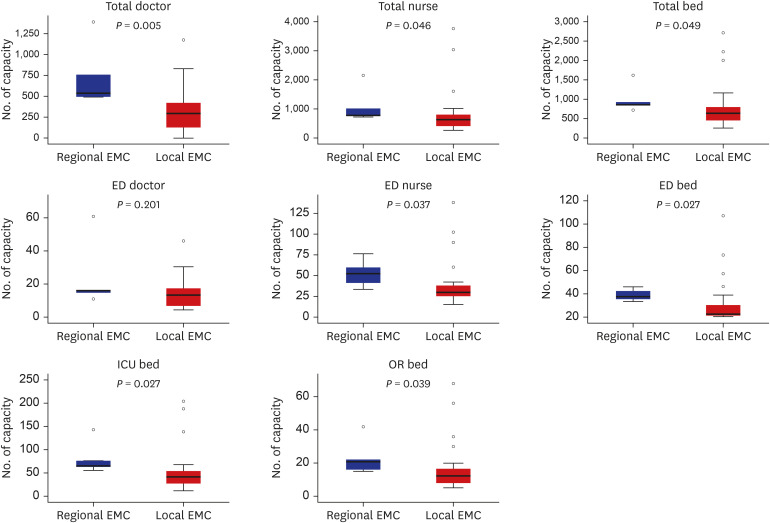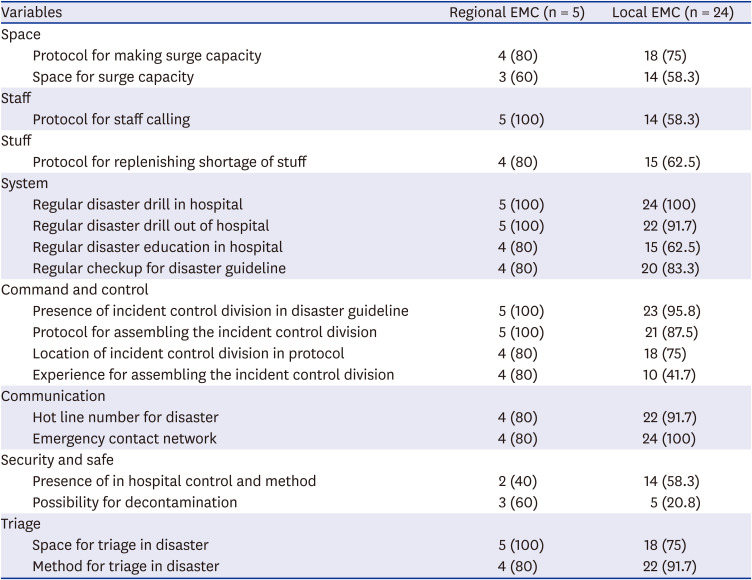1. Smith JE, Gebhart ME. Patient surge. In : Ciottone GR, editor. Ciottone's Disaster Medicine. 2nd ed. Philadelphia, PA, USA: Elsevier;2015. p. 233–240.
2. Barbisch DF. Surge capacity and scarce resource allocation. In : Koenig KL, Schultz CH, editors. Koenig and Schultz's Disaster Medicine. 2nd ed. Cambridge, UK: Cambridge University Press;2016. p. 38–51.
3. Hick JL, Hanfling D, Burstein JL, DeAtley C, Barbisch D, Bogdan GM, et al. Health care facility and community strategies for patient care surge capacity. Ann Emerg Med. 2004; 44(3):253–261. PMID:
15332068.

4. Barbera JA, Macintyre AG, Knebel A, Trabert E. Medical Surge Capacity and Capability: a Management System for Integrating Medical and Health Resources During Large-Scale Emergencies. 2nd ed. Washington, D.C.: US Department of Health and Human Services;2007.
5. American College of Emergency Physicians. Health care system surge capacity recognition, preparedness, and response. Ann Emerg Med. 2005; 45(2):239. PMID:
15671992.
6. Barbisch DF, Koenig KL. Understanding surge capacity: essential elements. Acad Emerg Med. 2006; 13(11):1098–1102. PMID:
17085738.

7. Kaji A, Koenig KL, Bey T. Surge capacity for healthcare systems: a conceptual framework. Acad Emerg Med. 2006; 13(11):1157–1159. PMID:
16968688.

8. Sheikhbardsiri H, Raeisi AR, Nekoei-Moghadam M, Rezaei F. Surge capacity of hospitals in emergencies and disasters with a preparedness approach: a systematic review. Disaster Med Public Health Prep. 2017; 11(5):612–620. PMID:
28264731.

9. Hick JL, Einav S, Hanfling D, Kissoon N, Dichter JR, Devereaux AV, et al. Surge capacity principles: care of the critically ill and injured during pandemics and disasters: CHEST consensus statement. Chest. 2014; 146(4):Suppl. e1S–e16S. PMID:
25144334.
10. De Boer J. Order in chaos: modelling medical management in disasters. Eur J Emerg Med. 1999; 6(2):141–148. PMID:
10461559.

11. Hirshberg A, Scott BG, Granchi T, Wall MJ Jr, Mattox KL, Stein M. How does casualty load affect trauma care in urban bombing incidents? A quantitative analysis. J Trauma. 2005; 58(4):686–693. PMID:
15824643.

12. Rivara FP, Nathens AB, Jurkovich GJ, Maier RV. Do trauma centers have the capacity to respond to disasters? J Trauma. 2006; 61(4):949–953. PMID:
17033567.

13. Bayram JD, Zuabi S, Subbarao I. Disaster metrics: quantitative benchmarking of hospital surge capacity in trauma-related multiple casualty events. Disaster Med Public Health Prep. 2011; 5(2):117–124. PMID:
21685307.

15. Lee MS, Kang RH, Ham BJ, Choi YK, Han CS, Lee HJ, et al. A study of disaster survivors in Korea. Psychiatry Investig. 2004; 1(1):68–75.
16. Kwon H, Kim YJ, Jo YH, Lee JH, Lee JH, Kim J, et al. The Korean Triage and Acuity Scale: associations with admission, disposition, mortality and length of stay in the emergency department. Int J Qual Health Care. 2019; 31(6):449–455. PMID:
30165654.

18. Lin YK, Niu KY, Seak CJ, Weng YM, Wang JH, Lai PF. Comparison between simple triage and rapid treatment and Taiwan Triage and Acuity Scale for the emergency department triage of victims following an earthquake-related mass casualty incident: a retrospective cohort study. World J Emerg Surg. 2020; 15(1):20. PMID:
32156308.

19. Cha MI, Choa M, Kim S, Cho J, Choi DH, Cho M, et al. Changes to the Korean disaster medical assistance system after numerous multi-casualty incidents in 2014 and 2015. Disaster Med Public Health Prep. 2017; 11(5):526–530. PMID:
28659222.

20. Cha MI, Kim GW, Kim CH, Choa M, Choi DH, Kim I, et al. A study on the disaster medical response during the Mauna Ocean Resort gymnasium collapse. Clin Exp Emerg Med. 2016; 3(3):165–174. PMID:
27752635.

21. Terndrup TE, Leaming JM, Adams RJ, Adoff S. Hospital-based coalition to improve regional surge capacity. West J Emerg Med. 2012; 13(5):445–452. PMID:
23316266.

22. Schultz CH, Stratton SJ. Improving hospital surge capacity: a new concept for emergency credentialing of volunteers. Ann Emerg Med. 2007; 49(5):602–609. PMID:
17112633.

23. TariVerdi M, Miller-Hooks E, Kirsch T. Strategies for improved hospital response to mass casualty incidents. Disaster Med Public Health Prep. 2018; 12(6):778–790. PMID:
29553040.

24. Park JO, Shin SD, Song KJ, Hong KJ, Kim J. Epidemiology of emergency medical services-assessed mass casualty incidents according to causes. J Korean Med Sci. 2016; 31(3):449–456. PMID:
26955248.

25. Waxman DA, Chan EW, Pillemer F, Smith TW, Abir M, Nelson C. Assessing and improving hospital mass-casualty preparedness: a no-notice exercise. Prehosp Disaster Med. 2017; 32(6):662–666. PMID:
28780916.

26. Abir M, Davis MM, Sankar P, Wong AC, Wang SC. Design of a model to predict surge capacity bottlenecks for burn mass casualties at a large academic medical center. Prehosp Disaster Med. 2013; 28(1):23–32. PMID:
23174042.

27. Jacobs-Wingo JL, Cook HA, Lang WH. Rapid patient discharge contribution to bed surge capacity during a mass casualty incident: findings from an exercise with New York City hospitals. Qual Manag Health Care. 2018; 27(1):24–29. PMID:
29280904.

28. Kelen GD, Kraus CK, McCarthy ML, Bass E, Hsu EB, Li G, et al. Inpatient disposition classification for the creation of hospital surge capacity: a multiphase study. Lancet. 2006; 368(9551):1984–1990. PMID:
17141705.

29. Kelen GD, Troncoso R, Trebach J, Levin S, Cole G, Delaney CM, et al. Effect of reverse triage on creation of surge capacity in a pediatric hospital. JAMA Pediatr. 2017; 171(4):e164829. PMID:
28152138.

30. Kanter RK, Moran JR. Hospital emergency surge capacity: an empiric New York statewide study. Ann Emerg Med. 2007; 50(3):314–319. PMID:
17178173.

31. DeLia D. Annual bed statistics give a misleading picture of hospital surge capacity. Ann Emerg Med. 2006; 48(4):384–388. 388.e1–388.e2. PMID:
16997673.

32. National Center for Health Statistics. Health, United States, 2005 with Chartbook on Trends in the Health of Americans. Hyattsville, MD, USA: National Center for Health Statistics;2005.
34. Lee WH, Ghee C, Wu KH, Hung SC. Barriers to surge capacity of an overcrowded emergency department for a serious foodborne disease outbreak. Emerg Med J. 2010; 27(10):779–783. PMID:
20378747.

35. Shartar SE, Moore BL, Wood LM. Developing a mass casualty surge capacity protocol for emergency medical services to use for patient distribution. South Med J. 2017; 110(12):792–795. PMID:
29197316.











 PDF
PDF Citation
Citation Print
Print





 XML Download
XML Download